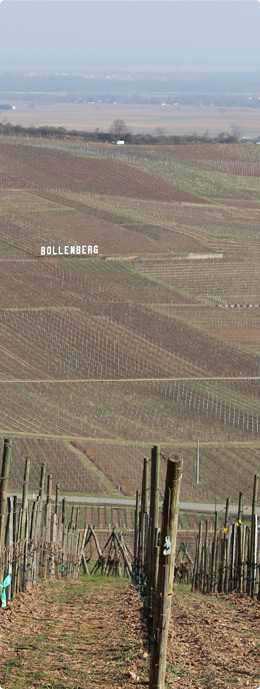

AOP’s
Bollenberg
The hill of Bollenberg is located between Rouffach and Guebwiller. At an altitude of 363 m it has rich soils which vary depending on the area; from Muschelkalk to late-Jurassic limestone. It is one of the biggest limestone hills and has an area of 300 hectares.
The Bollenberg region has one of the lowest levels of rainfall in Europe of between 400 and 500 mm per year. This is thanks to the shelter from the rain provided by the Grand Ballon (the apex of the Vosges) and the Vosges mountain range. The exceptional amount of sunshine provides favourable conditions for a rare type of Mediterranean flora and the proliferation of an exclusive fauna. Furthermore a large part of the hill is classed as a protected area.
Historically called Bellenberg, the name coming from God “Belen” or “Benelus”; the Celt God of Fire associated with pastoral life. The “Mont de Belen” is said to be an ancient place of sun worship.
Enchenberg
Enchenberg is in the Vieux-Thann area, located at the mouth of the Thann valley, which has an area of 4 hectares, is at an altitude of between 350 and 400 m and is fully south facing.
This area’s soil is made up of glacial moraines which are the result of glacier erosion. The soil is extremely dry and gravelly which makes its preparation difficult. The mineral concentration is particularly low in this type of soil and therefore the yield is also low.
The hillside which had been used to grow grapes since the XVIth Centaury was abandoned by its successive owner after WWII because of the steepness (40%). From 1988 onwards it was bought progressively by the Château d’Orschwihr, transformed into terraces and farmed from 1990, becoming a monopole[1] in 2005.
This terroir[2], used exclusively for growing Riesling and Pinot Gris, gives its grapes a mineral richness and elegance worthy of the great vins de garde.[3]
[1] An area controlled by a single winery.
[2] A terroir is a group of vineyward from the same region, belonging to a specific appellation, and sharing the same type of soil, weather conditions, grapes and wine-making savoir faire, which contribute to its specific personality of wine.
[3] Wine with the potential to improve with age.
